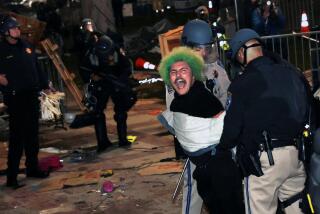Project Rescue : Protesters Want Police to Stop Using <i> Nunchakus</i>
- Share via
Complaining of broken bones, dislocated shoulders, torn tendons and nerve damage to their wrists, more than a dozen anti-abortion protesters Wednesday called on a police advisory board to recommend that San Diego officers no longer use nunchakus and other pain compliance techniques on peaceful demonstrators.
The protesters, who have been arrested at recent weekend rallies, also criticized many police officers for seeming to enjoy hurting the members of Project Rescue who refused to obey a court order and stop blocking the front of abortion clinics.
Robert Rousen said many of the officers were “sneering, mocking and full of laughter” as they injured the protesters to force them to abandon their demonstrations.
Dawn Bell of Escondido added: “I feel like a lot of the police officers had a personal vendetta. I saw one man thrown into a police car, and I saw one officer smile and say, ‘Go ahead and hurt him. He just loves it.’ ”
The Citizens’ Advisory Board on Police/Community Relations took no immediate action on the recommendations from the group. Andrea Skorepa, acting chairwoman of the panel, said it was the largest public gathering to address the board in its four-year history.
The board has only advisory authority, but according to city officials more than 90% of its recommendations have been adopted by police.
Committee to Study
But the panel did form an ad hoc committee to study the issue of pain compliance by police officers, and the full board is expected to vote on the matter when it meets again next month.
George Penn, an assistant to the city manager, read a letter from City Manager John Lockwood in which he defended the use of pain compliance against civil demonstrators who refuse to obey lawful orders.
“Pain compliance techniques are neither bizarre nor cruel and rarely result in injury,” the letter said. “The amount of pressure applied is directly proportionate to the amount of resistance offered.”
Deputy Chief Manuel C. Guaderrama, a member of the advisory board, also defended the use of nunchakus, a relatively new police tool that is applied to a person’s wrist or arm and then twisted to inflict pain.
“We have a responsibility as a Police Department to make sure that laws are not violated,” he said. “And we are only going to use the amount of force we believe is absolutely necessary.”
Penn said several of the protesters have filed formal complaints alleging excessive force with the department’s Internal Affairs unit. He also said that several protesters have filed monetary claims against the city.
But exactly how many protesters were injured, and how serious those injuries actually were, remained unclear. None of the protesters speaking at the Wednesday meeting were wearing arm bandages, casts or slings.
Glen Phelps, a spokesman for the group, said 30 to 40 people were severely injured and required medical attention, including one Fallbrook doctor who suffered a broken bone in his hand.
“He’s been unable to practice surgery for three weeks or so,” Phelps said.
Connie Youngkin, another Project Rescue activist, said she saw an officer twist a woman’s arm behind her back, causing a dislocated shoulder and severe damage to the nerves and tendons on the woman’s arm.
“Now she is permanently damaged,” Youngkin said.
Richard Bell of Escondido said he witnessed another woman’s arm being broken. “She tried to walk, and they were dragging her,” he said. “Another police officer came up and said, ‘Let up, you’re going to break her arm.’ But it was too late. Her arm was already broken.”
Used When Necessary
Police said the officers have used the pain compliance method only after protesters repeatedly refused to obey verbal orders to move away from clinic doors and entryways.
Many of those speaking to the advisory panel suggested that police instead use stretchers and wheelchairs to remove protesters. They also said officers should pick up protesters or drag them away.
Police said such strenuous activity could cause injuries to the officers, such as straining their backs. But the protesters discounted that argument.
“If they’re hurting their backs, then they’re not in shape to be police officers,” said Joanne Marsh of Santee.
“A stretcher saves the policeman’s back,” added Sylvia Sullivan of Lemon Grove. “And his public image.”
Although most of the speakers were critical of the officers, a few in the audience stood to offer support for the Police Department’s decision to use pain compliance.
Betty Dempsey, an administrator of O & B Medical Group Inc., said that, although the protesters pretend to be nonviolent, they actually pose a serious threat to medical patients who are trying to enter the clinics.
“What about the patients who want to get in the buildings for medical purposes?” she said. “We are the victims, and police should use whatever is tried and true to accomplish what they need to have to remove a crowd.”
More to Read
Sign up for Essential California
The most important California stories and recommendations in your inbox every morning.
You may occasionally receive promotional content from the Los Angeles Times.











